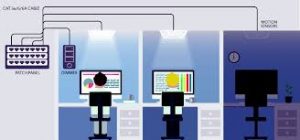The Internet of Things is something that has been developing fairly rapidly over recent years. It is how we connect things—mostly machines—together using a digital network so they can all communicate with each other, and you with them. Some recent examples of the Internet of Things would be new cars that you can lock and unlock from your mobile device. It could be using your phone to turn on your home security system or modify its settings. These could also be machines or appliances that signal you when something is broken or starting to fail. You know that “change filter” light that always seems to be blinking? In the Internet of Things, it would send you an email instead; it might even order the filter itself.
The Internet of Things isn’t just limited to the simple on/off technologies. Through the use of sensors, we can revolutionize the way we do most everything. From understanding traffic patterns to health monitoring and predicting catastrophe, the Internet of Things provides the opportunity to track an understanding of our lives from a new, digital perspective.
HOW DOES LIGHTING FIT IN?
Digital lighting is something we have immediate access to thanks to LED bulb technology. LED lights are digital in nature; they run off electricity that is transmitted through a circuit board. The next wave of LED lighting technology is a smart bulb which has built-in remote controls. This could be anything from turning lights on and off, to dimming and efficiency programming.
However, that is just the tip of the iceberg. LEDs were introduced as an answer to inefficient lighting options that consumed too much energy. But what engineers and scientists noted was that LED lights are capable of connecting to a network; something no incandescent bulb could ever hope to achieve. Our lighting system already penetrates every aspect of our lives—they run through all of our buildings, they light our streets and direct our traffic. Adapting our LED technology into our existing lighting network could be a simple and readily available beginning to an extensive network.
LI-FI
Lighting technology is taking turns we may never have expected. We don’t use light just to see a little better or brighten up a room. Now light itself may be used as a wireless data network called Li-Fi.
The idea behind Li-Fi is similar to Wi-Fi. Wi-Fi works by transmitting data over radio waves. Li-Fi would work the same way, but it would be transmitting data over visible light. Creating this network would also take advantage of the technology of an LED bulb. Engineers working on Li-Fi claim its speeds could reach that of 100 times what is available on a Wi-Fi network. As we have already seen, lighting is everywhere; this means fixtures in every room of your facility could be producing data networks for your devices to connect to. That’s right—every light you have could be its own wireless router. This technology is still new but it is quickly getting ready to creep onto the market.
If you haven’t yet made the conversion to LEDs in your facility, it might be time to look into what a switch out could mean for you. They are leading the way in new digital lighting technologies that a few years ago weren’t even imagined. Aside from their potential future benefits, they can be a more sustainable lighting choice than other lamps you may be using now. Their low energy consumption and long lifetimes could lead to savings and a greener facility. And you never know—it could hook you up to new technologies sooner than you think.
